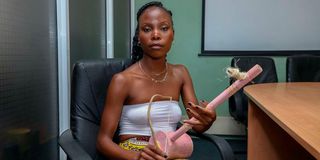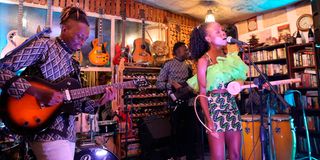Premium
Kenyan Orutu player Labdi Ommes composing music for National Geographic documentaries

Labdi Ommes.She is an orutu player who sings and performs traditional Luo music. She specializes in Ohangla Jazz and African folk music.
Traditional musical instruments are slowly but surely losing their influence as young people embrace more western and urban sounds. The Orutu is no different. The single-stringed fiddle is held horizontally while being played using a bow.
The Luo are known for their strong tradition of stringed instruments and are famous for their skills with harps and lyres. Traditionally, women were not allowed to play instruments like the nyatiti (a musical instrument that typically has eight strings) and orutu. But Labdi Ommes takes pride in breaking this gender barrier and becoming a professional orutu player, a rarity in the community.
“I started singing after I finished high school. I signed up for music classes but when I sang, I was told my voice was a bit too ‘African’ and was advised to find an instrument to complement it. My uncle, who is also a musician, further advised me to get a traditional instrument because those are the kind that gets you opportunities.
I fell in love with the orutu when I joined Kenyatta University to study Fine Arts. I was told that women are not allowed to play it but to me, that sounded like a good reason to play it,” she says.
After one class, Labdi was not able to get a teacher to instruct her so she taught herself how to handle the instrument. When she began performing, she slowly started to see the repercussions of ‘breaking tradition’.
“In the beginning, I was a bit naive. I had not thought about the backlash and was still wondering why women were not allowed to play. There was a time I was playing and someone shouted at me during a show and I had to stop performing.
My grandfather also asked me if I was sure I wanted to play the orutu. It has not been as bad as I expected but I still meet people who believe in gender roles. Men and women also had specific roles in traditional music,” she told Lifestyle.

Labdi Ommes during the interview on March 23.
In most communities, playing instruments was part of the power dynamics, which is why it was unusual to find women handling them, and they usually only danced or sang.
Gordon Onyango, who wrote about the changing trends of music performance in the Luo community, explained in his writing that the participation of women in music performance was restricted such that they could only sing or dance when the men played the instruments since they were not allowed to play or even touch them.
Labdi says various versions of the orutu can be found in other communities around the world, only varying in size. It is known as Wandindi in some Bantu communities such as the Agikuyu, Aembu and Ameru.
“In Ethiopia, it is called the masenqo. It is bigger but it is the same concept. You still use the bow to produce sound,” she says as she demonstrates using her instrument.
From watching her play her pink-coloured orutu, the instrument creates different notes determined by the coordination between the finger pressure applied on the string and the drawing of the bow across the single string to create a melody as the musician pleases.
“I have three orutus. I like the pink one because it is shorter and has a different timbre. The longer the orutu, the further the placement of your fingers have to be while playing,” she says.
The orutu consists of a hollow wooden box — most commonly made from a hallowed out tree trunk — that has animal skin stretched over one side and is open at the bottom. The string is made from a variety of re-purposed materials, including bicycle brake cables, while the part of the bow used to play is made up of sisal fibre tied across a wooden handle. The instrument can be played on its own or to provide a fast-moving, melodic accompaniment to the original ohangla sound that traditionally is a combination of different drums.
However, Labdi expresses her disappointment in music stores that do not sell traditional instruments or even fix them.
“If my orutu breaks today, I am done. My orutu is made out of recycled plastic and was crafted by my music teacher from Kenyatta University. I wish that one day I can buy an orutu bow in a music shop in Nairobi,” she says.
A spot check by Lifestyle showed that orutus are sold online ranging between Sh3,500 and Sh 8,000 exclusive of delivery fees. In two of the shops surveyed, the instrument was sold out or not in stock.
Coupled with the soft sound of her pink orutu and her unique voice, Labdi takes pride in singing in Dholuo, which has made her stand out from other younger musicians who choose to emulate western musicians and sing in English or Kiswahili.

Labdi Ommes performing with Don Tambo (bass guitar), Henry Ngugi (lead guitar) and Mwangangi Kyalo (percussionist) at Geco cafe at a past event.
It was not long before people began recognising her talent and calling her to perform at local events and work with creative hubs such as Goethe Institut, the German cultural centre in Nairobi. Soon after, she was performing at international festivals and concerts such as the Oslo Afro Arts Festival, Bergen International Music Festival, Noise on the Nile, Nyege Nyege in Uganda, and GMA Addis Ababa.
“I have always taken chances and been open to collaborations. That is how I have been able to meet new people and travel,” she says.
Labdi is also part of a cross-cultural duo called Unganisha that she formed with an experimental electronic artist from Norway known as Bernt Isak Wærstad. The two have fused African traditional sounds with electronic beats and have released more than 10 songs, including a collaboration with Kenyan percussionist Kasiva Mutua for the song Lwang’ni Hotel.
“I think the more authentic your sound is, the easier it is to manipulate across all genres as opposed to singing other genres such as gengetone,” she says.
It was her unique sound that earned her a spot in a composer lab project by Nature, Environment, Wildlife Filmmaking (NEWF) in Durban last year.
Labdi and three other African musicians from Mozambique, Morocco, and South Africa were selected for a fellowship that taught them how to compose music for films with hopes to diversify the soundscapes of African wildlife documentaries. She says that their mentor, French Lebanese composer Samuel Safa, even had to learn English before he came to teach them as there needs to be more African composers who have experience with making music for films.
“Usually when you watch a wildlife documentary, you would probably hear classical music in the background even if it is based in Africa. We should aim to change that as sound in films sets the mood and the tone of how you will internalise the documentary,” Labdi said.
The group was among the first people of African descent to compose music for the National Geographic Society in the recent documentary, Nkashi: Race for the Okavango, which premiered in March this year in Gaborone, Botswana. The documentary was also made by African filmmakers, which is the first project to be released by the National Geographic Society as they promise that more African documentaries will be made by African creatives.
Nkashi: Race for the Okavango tells the story of three mokoro (traditional dugout canoe) polers in Botswana’s Okavango Delta as they prepare for the annual Nkashi Classic, a time-trial race founded in 2018 by the Botswana Wild Bird Trust (BWBT) that attracts the fastest mokoro polers in the Delta. Nkashi refers to the long pole that they use to push themselves through the world's largest inland delta as it is the only means of transport that can penetrate through the thick water plants.
“Before Nkashi, we had scored for other wildlife and cultural films such as Reformed by Samson Moyo and many others. When we were performing the score from Reformed in Austria, the NatGeo team liked what we did and asked us to write for their film that will be based in Botswana. They took us to the Okavango Delta to experience the nature of the place and the people so that we can write music that depicts that. Then we got to perform what we came up with in Washington DC,” she says.
Her music has become her main source of income, especially through projects and collaborations. Even during the 2020 Covid-19 lockdown that brought the whole country to a standstill, Labdi was working on projects that kept her afloat and also helped her support her sister who was living with her. She says that most musicians do not make money from their music, especially since streaming is free or easily accessible online.
“What you are paid depends on the duration of the project and the scope of the work. Some can take three months and others are dependent on how fast you can get a project done. Live shows can pay more than $5,000 but you also have to pay your band members. It also depends on the kind of rates that you have. I usually take on many different projects. That is how I am able to survive. If I stuck only to performing, I would be broke,” she says.
Labdi says it is possible to have a successful music career but worries that tens of Kenyan musicians lack funding to pursue their dreams. It is even worse for female artistes who are often sexually harassed and shunned for speaking out.
“We do not have the same tools of access as musicians in other countries. For instance, in Norway, musicians have several options to choose from when it comes to funding. Here in Kenya, we rely on foreigners and donors to support the industry,” she says.
The 28-year-old artist composes songs from indigenous Kenyan genres such as taarab, ohangla, mwomboko, and benga, which she learnt while living in Nairobi and Kisumu. She hopes to popularise African music culture, sounds, and indigenous instruments to reintroduce them to the world, which has been made possible with collaborations with various artists from different parts of the world and composing music for wildlife and environment films and documentaries.





